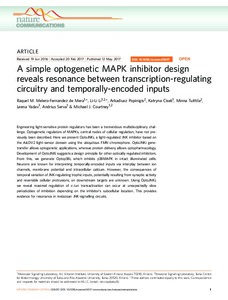| dc.contributor.author | de Mera RMMF | |
| dc.contributor.author | Serva A | |
| dc.contributor.author | Tuittila M | |
| dc.contributor.author | Li LL | |
| dc.contributor.author | Popinigis A | |
| dc.contributor.author | Courtney MJ | |
| dc.contributor.author | Cisek K | |
| dc.contributor.author | Yadav L | |
| dc.date.accessioned | 2022-10-28T13:57:06Z | |
| dc.date.available | 2022-10-28T13:57:06Z | |
| dc.identifier.uri | https://www.utupub.fi/handle/10024/168481 | |
| dc.description.abstract | Engineering light-sensitive protein regulators has been a tremendous multidisciplinary challenge. Optogenetic regulators of MAPKs, central nodes of cellular regulation, have not previously been described. Here we present OptoJNKi, a light-regulated JNK inhibitor based on the AsLOV2 light-sensor domain using the ubiquitous FMN chromophore. OptoJNKi genetransfer allows optogenetic applications, whereas protein delivery allows optopharmacology. Development of OptoJNKi suggests a design principle for other optically regulated inhibitors. From this, we generate Optop38i, which inhibits p38MAPK in intact illuminated cells. Neurons are known for interpreting temporally-encoded inputs via interplay between ion channels, membrane potential and intracellular calcium. However, the consequences of temporal variation of JNK-regulating trophic inputs, potentially resulting from synaptic activity and reversible cellular protrusions, on downstream targets are unknown. Using OptoJNKi, we reveal maximal regulation of c-Jun transactivation can occur at unexpectedly slow periodicities of inhibition depending on the inhibitor's subcellular location. This provides evidence for resonance in metazoan JNK-signalling circuits. | |
| dc.language.iso | en | |
| dc.publisher | NATURE PUBLISHING GROUP | |
| dc.title | A simple optogenetic MAPK inhibitor design reveals resonance between transcription-regulating circuitry and temporally-encoded inputs | |
| dc.identifier.url | http://www.nature.com/articles/ncomms15017 | |
| dc.identifier.urn | URN:NBN:fi-fe2021042716942 | |
| dc.relation.volume | 8 | |
| dc.contributor.organization | fi=Turun biotiedekeskus|en=Turku Bioscience Centre| | |
| dc.contributor.organization | fi=PÄÄT JBL-laboratorio|en=PÄÄT Joint Biotechnology Laboratory (JBL)| | |
| dc.contributor.organization-code | 2609201 | |
| dc.contributor.organization-code | 2606305 | |
| dc.converis.publication-id | 24961009 | |
| dc.converis.url | https://research.utu.fi/converis/portal/Publication/24961009 | |
| dc.identifier.eissn | 2041-1723 | |
| dc.identifier.jour-issn | 2041-1723 | |
| dc.okm.affiliatedauthor | Li, Lili | |
| dc.okm.affiliatedauthor | Popinigis, Arkadiusz | |
| dc.okm.affiliatedauthor | Courtney, Michael | |
| dc.okm.affiliatedauthor | Tuittila, Minna | |
| dc.okm.discipline | 3112 Neurosciences | en_GB |
| dc.okm.discipline | 222 Muu tekniikka | fi_FI |
| dc.okm.discipline | 3111 Biomedicine | en_GB |
| dc.okm.discipline | 222 Other engineering and technologies | en_GB |
| dc.okm.discipline | 1182 Biokemia, solu- ja molekyylibiologia | fi_FI |
| dc.okm.discipline | 1182 Biochemistry, cell and molecular biology | en_GB |
| dc.okm.discipline | 3112 Neurotieteet | fi_FI |
| dc.okm.discipline | 3111 Biolääketieteet | fi_FI |
| dc.okm.internationalcopublication | not an international co-publication | |
| dc.okm.internationality | International publication | |
| dc.okm.type | Journal article | |
| dc.relation.articlenumber | ARTN 15017 | |
| dc.relation.doi | 10.1038/ncomms15017 | |
| dc.relation.ispartofjournal | Nature Communications | |
| dc.year.issued | 2017 | |
